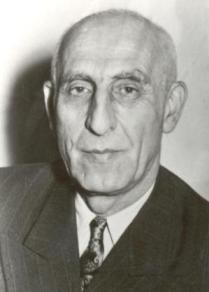
Mohammad Mosaddegh was an Iranian politician, author, and lawyer who served as the 35th Prime Minister of Iran from 1951 to 1953, after appointment by the 16th Majlis. He was a member of the Iranian parliament from 1923, and served through a contentious 1952 election into the 17th Iranian Majlis, until his government was overthrown in the 1953 Iranian coup d'état aided by the intelligence agencies of the United Kingdom (MI6) and the United States (CIA), led by Kermit Roosevelt Jr. His National Front was suppressed from the 1954 election.

The National Front of Iran is an opposition political organization in Iran, founded by Mohammad Mosaddegh in 1949. It is the oldest and arguably the largest pro-democracy group operating inside Iran despite having never been able to recover the prominence it had in the early 1950s.

Ali Razmara, also known as Haj Ali Razmara, was a military leader and prime minister of Iran.
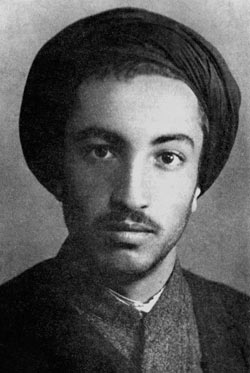
Sayyid Mojtaba Mir-Lohi, more commonly known as Navvab Safavi, was an Iranian Shia cleric and founder of the Fada'iyan-e Islam group. He played a role in assassinations of Abdolhossein Hazhir, Haj Ali Razmara and Ahmad Kasravi. On 22 November 1955, after an unsuccessful attempt to assassinate Hosein Ala', Navvab Safavi and some of his followers were arrested. In January 1956, Safavi and three other members of Fada'iyan-e Islam were sentenced to death and executed.

Hossein Fatemi was an Iranian scholar. A close associate of Prime Minister Mohammad Mosaddegh, he proposed nationalization of Iranian oil and gas assets. Initially a journalist, he served as minister of foreign affairs from 1951 to 1953. After the 1953 coup d'état toppled the government of Mosaddegh, Fatemi was arrested, tortured, and convicted by a military court of "treason against the Shah", and executed by a firing squad.

Hosein Alā was an Iranian politician who served as Prime Minister in 1951 and from 1955 to 1957.

Hasan Ali Mansur was an Iranian politician who served as Prime Minister from 1964 to 1965. He served during the White Revolution of the Shah Mohammad Reza Pahlavi and was assassinated by a member of the Fada'iyan-e Islam.

Fadā'iyān-e Islam is a Shia fundamentalist group in Iran with a strong activist political and terrorist orientation. The group was founded in 1946, and registered as a political party in 1989. It was founded by a theology student nicknamed Navvab Safavi. Safavi sought to purify Islam in Iran by ridding it of 'corrupting individuals' by means of carefully planned assassinations of certain leading intellectual and political figures.
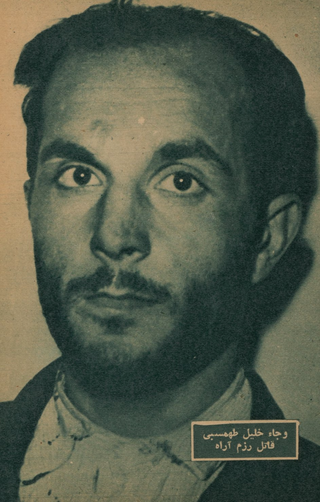
Khalil Tahmasebi was a carpenter and member of the Iranian fundamentalist group Fadayan-e Islam, which has been described as "the first Shiite Islamist organization to employ terrorism as a primary method of political activism." On behalf of this group, Tahmasebi assassinated the Iranian Prime Minister, Ali Razmara, on 7 March 1951. He was described as a "religious fanatic" by The New York Times. In 1952, he was freed by the Iranian Parliament during the premiership of Mosaddegh, his pending death sentence was quashed, and he was declared a "Soldier of Islam." According to Time, Tahmasebi "promptly rushed to the Hazrat Abdolazim shrine, wept joyously and said: 'When I killed Razmara, I was sure that his people would kill me.'" Following the 1953 Iranian coup d'état, Tahmasebi was re-arrested and tried for the assassination of Razmara; he was executed in 1955.
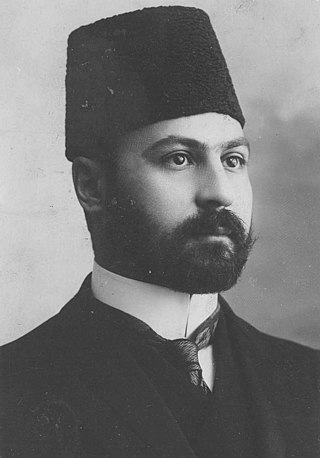
Hassan Pirnia, was a prominent Iranian politician of 20th-century Iran. He held a total of twenty-four posts during his political career, serving four times as Prime Minister of Iran. He was also a historian, co-founding the Society for the National Heritage of Iran.
Mohsen Rais, also known as Mirza Mohsen Khan, was an Iranian diplomat and served as foreign minister and as ambassador during the Pahlavi era.

The nationalization of the Iranian oil industry resulted from a movement in the Iranian parliament (Majlis) to seize control of Iran's oil industry, which had been run by private companies, largely controlled by foreign interests. The legislation was passed on March 15, 1951, and was verified by the Majlis on March 17, 1951. The legislation led to the nationalization of the Anglo-Iranian Oil Company (AIOC). The movement was led by Mohammad Mosaddegh, a member of the Majlis for the National Front and future prime minister of Iran. The movement to nationalize the oil industry was the reaction to the following concessions made by Iran to foreign powers: the Reuter concession of 1872, proceeding letter,D'Arcy Concession?] the 1933 agreement between the Iranian government and AIOC, and the Gas-golshaian[?] contract. According to the political scientist Mark J. Gasiorowski, the oil nationalization movement had two major results: the establishment of a democratic government and the pursuit of Iranian national sovereignty.
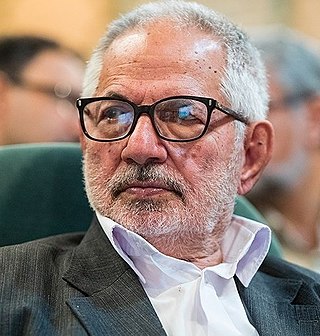
Mohammad-Mehdi Abdekhodaei is an Iranian conservative activist.
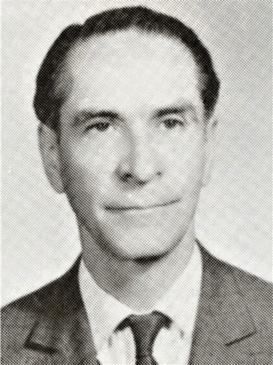
Shamseddin Amir-Alai was an Iranian politician who served as both interior minister and justice minister in the first cabinet of Mohammad Mosaddegh. He also held other government and diplomatic posts.
Bakhtar-e Emruz was a Persian-language daily newspaper published in the period 1949–1953. The paper is known for its founder and editor Hossein Fatemi, an executed journalist and minister of foreign affairs, and for its affiliation with the National Front. The title of the paper was a reference to two former newspapers which had been published and contributed by Fatemi, namely Bakhtar and Mard-i Imruz.

Abdollah Hedayat (1899–1968) was an army officer who served as the chief of general staff at the Imperial Iran Army.
Javad Bushehri, also known as Amir Homayun, was an Iranian businessman and statesman who held several government posts. In addition, he served at the Majlis and Senate and also, was the governor of the Fars province.
Mohammad Masud (1905–1948) was an Iranian journalist and writer. He published some books and launched a weekly newspaper, Mard-i Imruz. He was an ardent critic of the Pahlavi rule and Ahmad Qavam. Masud was assassinated in February 1948.
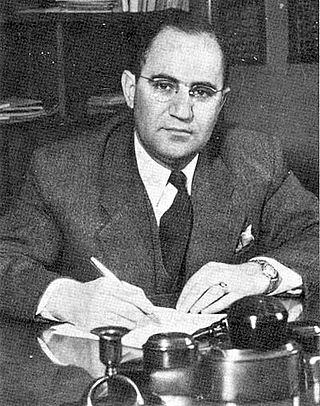
Jahanshah Saleh (1905–1995) was an Iranian physician and politician. He served as health minister and education minister in the 1950s and 1960s. He was the obstetrician of Queen Farah Diba, spouse of Shah Mohammad Reza Pahlavi.
The cabinet led by Hossein Ala' was formed on 20 March 1951 two weeks after the assassination of Prime Minister Haj Ali Razmara. The cabinet was given vote of confidence at the Majlis on 17 April 1951. However, the tenure of the cabinet was very short and lasted only until 27 April when Hossein Ala' resigned from office due to threats of the Fada'iyan-e Islam members who had murdered Haj Ali Razmara. Another reason for the resignation of the cabinet was the ratification of the oil nationalization bill. It was succeeded by the cabinet formed by Mohammad Mosaddegh in late April.















